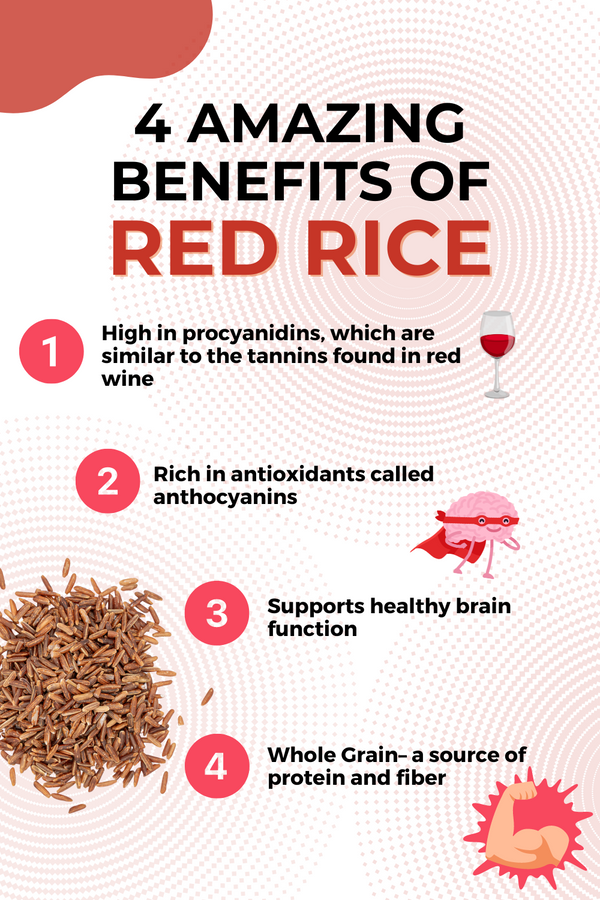The Benefits of Pigmented Rice
February 8, 2024
Lotus Foods' antioxidant-rich pigmented rice contains rich sources of health-promoting properties and are shown to be beneficial for a wide range of medical conditions including: reduction of oxidative stress, prevention of cancer, diabetes, and cardiovascular diseases. Our products are additive-free, organic, gluten-free, and grown on small family farms in areas that have some of the most fertile and unpolluted soils. Lotus Foods' founders' goal was to share their love affair with heirloom rice with American consumers. They knew that bringing the exciting colors and tastes of rice from around the world could help preserve rice biodiversity, increase farm incomes, and improve sustainability. We couldn't help but share the benefits of our Forbidden® and Organic Red pigmented rices.
Amazingly, pigmented rice is also studied to have anti-inflammatory, antioxidative and anticancer effects, and is considered a functional food. These rices have been used for strengthening kidney function, treating anemia, promoting blood circulation, removing blood stasis, treating diabetes, and ameliorating sight in traditional Chinese medicine. Consuming pigmented grain, which act as a source of resistant starch in the gut, can also reduce blood glucose levels.

Organic Forbidden® Rice & Heirloom Forbidden® Rice
Legend has it that this ancient grain, referred to as “longevity rice,” was eaten exclusively by the emperors of China to increase health and ensure a long life. Forbidden® Rice is treasured for its delicious roasted nutty taste, soft texture, nutritional content and beautiful deep purple color. This medium-size heirloom rice is grown in the Black Dragon River region of China's sub-arctic Northeast provinces, and is a natural source of antioxidants (anthocyanins), magnesium, protein and fiber. Organic Forbidden® Rice has health benefits associated with the functional ingredients, such as anti-inflammatory, antioxidative and anticancer effects. Black rice anthocyanins can inhibit cancer cells. Data also shows that the iron content in black rice is higher than in other rice types.
Healthline states that nutrients in purple rice include: antioxidants, fiber, protein, and iron. "Purple rice’s color is created by a flavonoid called anthocyanin pigment. This same pigment gives blueberries, eggplants, and other healthy fruits and vegetables their deep color. Anthocyanins are phytochemicals found in plants. They may also have anti-inflammatory and anti-carcinogenic properties. A powerful antioxidant, anthocyanin has been linked to reducing cases of diabetes, obesity, and heart disease. One study linked purple rice to cancer prevention in rats."
Forbidden® Rice is a natural source of antioxidants (anthocyanins), iron, magnesium, protein and fiber.

Grown on family farms in Thailand, this long grain rice retains its entire bran layer where all of the grain’s nutrients are stored. This whole grain cooks in only 30 minutes, producing a slightly nutty flavor and a toothsome yet tender grain. Red Rice is a natural source of antioxidants called anthocyanins. Organic Red Rice's antioxidant compounds have beneficial effects on health such as reduction of oxidative stress and prevention of cancer.
Red bran has exhibited strong inhibitory effects on leukemia, cervical, and stomach cancer cells and has over sevenfold higher both total antioxidant capacity and phenolic content. Also, traditional red varieties contain significantly higher levels of protein with well balanced amino acids and higher contents of fiber and vitamin E.
Red rices were highly valued as they had the power to redress the imbalance in the doshas - the cornerstone of Ayurvedic medicine. Red Rice saw a revival in India and Japan due to the high mineral, iron, and antioxidant contents, which make these rices an ideal health food. These rices have been used as food in India, China, Korea, and Japan for more than 3,000 years. In some areas of India, red rices are considered highly nutritive and medicinal.

Red Rice has a high mineral, iron, and antioxidant contents, which makes it an ideal health food.
Fun fact: The extracts from pigmented rice are used as natural food colorants. Pigmented rice is mainly black, red, and dark purple rice, and contain a variety of amino acids and essential oils.
Recipes to make with Lotus Foods' organic pigmented rice
We have SO MANY more rice recipes on our website!

Resources
Should I Add Purple Rice to My Diet?
The Genetic Basis and Nutritional Benefits of Pigmented Rice Grain
Phenolic compounds and bioactivities of pigmented rice
Nutraceutical potential of rice and wheat antioxidants and their impacts on health
Agriculture and Natural Resources
Anthocyanins: Natural Colorants with Health-Promoting Properties
Black rice anthocyanins inhibit cancer cells invasion via repressions of MMPs and u-PA expression.


